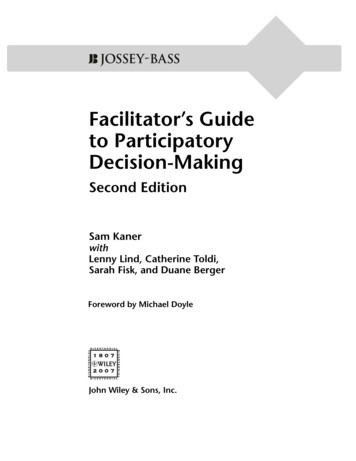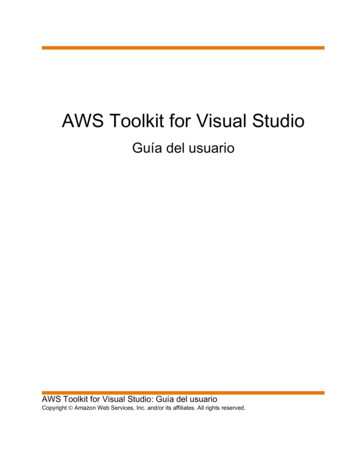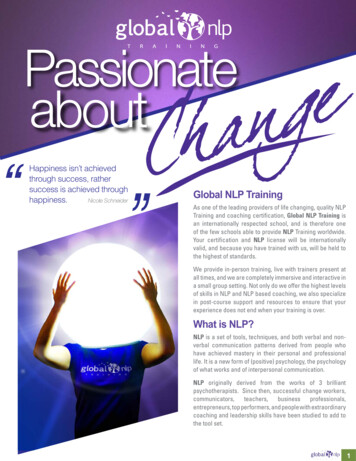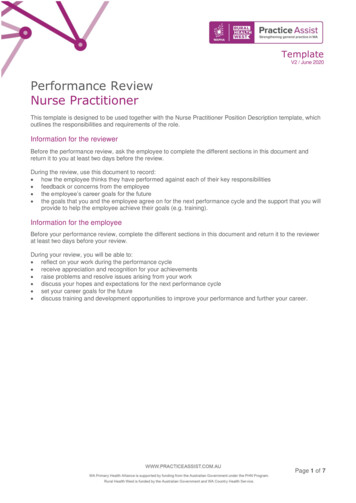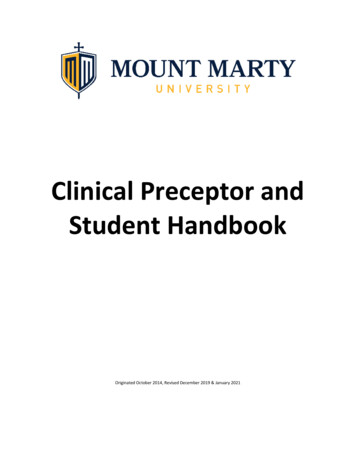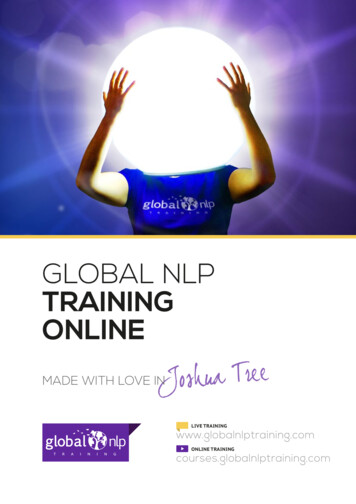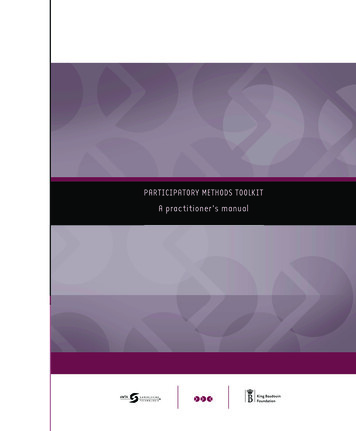
Transcription
PARTICIPATORY METHODS TOOLKIT A practitioner’s manualPARTICIPATORY METHODS TOOLKITA practitioner’s manual
ColofonParticipatory Methods ToolkitA practitioner’s manualThis manual is a joint publication of the King Baudouin Foundation and the Flemish Institute for Science andTechnology Assessment (viWTA) in collaboration with the United Nations University – Comparative Regional IntegrationStudies (UNU/CRIS).AuthorDr. Nikki Slocum, Research Fellow at UNU/CRISCoordinationAt viWTA: Stef Steyaert and Robby BerloznikAt King Baudouin Foundation: Caroline Beyne and Gerrit RauwsLayout and printingBelgian Advertising (B.AD)Legal depotD/2003/2893/31ISBN90-5130-447-1This publication is available, free of charge:On line via www.kbs-frb.be or www.viWTA.be or www.unu.cris.eduPer e-mail to publi@kbs-frb.be or viwta@vlaamsparlement.beOr by phone at the contact centre of the King Baudouin Foundation,tel. 32-70-233 728, fax 32-70-233 727With the support of the National LotteryDecember 2003
PARTICIPATORY METHODS TOOLKITA practitioner’s manualAuthor : Dr. Nikki SlocumResearch Fellow at United Nations University - Comparative Regional Integration Studies
PREFACEPREFACEIt is not unusual, as practitioners of participatory methods, to get requests for practical guidelines or approaches forparticipatory processes. Often we can send two or three articles, some web links, a more practical oriented descriptionof one or two methods or a case study.The feeling is familiar: as practitioners, we know how hard it is to find practical information. For some methodsthere is considerable documentation available, although it is often rather academic. For other methods, the questfor knowledge can be strenuous, especially if it concerns newer methods. In the fast developing field of participatoryapproaches, new methods are developed or brought into practice every day. Since the developers and practitionersof these methods are firstly interested in the ‘doing’ part, a lot of practical knowledge is being developed but littleis put on paper.To facilitate practical knowledge sharing, the King Baudouin Foundation and the Flemish Institute for Science andTechnology Assessment, both actively involved in participatory methods, decided to edit a publication with the ambitionto create a hands-on toolkit for starting up and managing participatory projects. Nikki Slocum of the United NationsUniversity in Bruges, the author of this manual, did a great job here. The core of the toolkit consist of 10 in depth fichesof just as many participatory methods. In addition to these fiches, you will find a brief overview of almost 40 othermethods and techniques. An introductory chapter, with a comparative chart of the discussed methods, and a chapterwith general guidelines for using participatory methods complete the toolkit.The manual is meant to be placed on many bookshelves: on that of the inexperienced person who sets first steps intothe challenging world of participation as well as on that of the experienced practitioner, who uses this manual forspecific sections, such as tips and tricks, or to get acquainted with other methods.The format is practical: this is a publication that you can put in a binder, split up into smaller parts, or photocopy.The format leaves you the opportunity to supplement the contents with additional documents and even add extrafiches in the same or another format. This publication is meant to be a working tool.So, where some prefaces end with the words ‘Enjoy reading’, we would like to end with ‘Enjoy working with it!’.King Baudouin FoundationFlemish Institute for Science and Technology Assessment5
Table of ContentsContents7Introduction9General guidelines and tips for participatory methods17Comparative chart for participatory methods25Charrette27Citizens Jury37Consensus Conference57Delphi75Expert Panel87Focus group97Participatory Assessment, Monitoring and Evaluation107Planning cell117Scenarios129The World Café141Brief descriptions of methods and techniques1537
INTRODUCTIONINTRODUCTIONWhat exactly do you mean by ‘a participatory approach’?A participatory approach advocates actively involving ‘the public’ in decision-making processes, whereby the relevant‘public’ depends upon the topic being addressed. The public can be average citizens, the stakeholders of a particularproject or policy, experts and even members of government and private industry. In general, policy processes can be seenas a three-step cycle of planning, implementation and evaluation, whereby a participatory approach may be used insome or all of these steps.Participative Policy ProcessParticipationParticipationin Evaluationin PlanningParticipation inImplementationDistinctions have been made between levels of participation, depending upon whether one’s objective is:transmitting information (unidirectional)consultation (bi-directional, but the consulted party frames the issue)active participation: based on a partnership in which citizens, stakeholders, experts and/or politicians activelyengage in (policy) debate. All parties involved can frame the issue to a greater or lesser extent.The contents of this toolkit refer to active participation. However, it should be noted that the level of participation is acontinuum and methods vary in the degree to which they engage participants in framing the questions and issues andin designing the procedures.Who wants a participatory approach?Participatory decision-making is not only desired and demanded by citizens who wish to play a more active role in thegovernance of their society. Regional, national and local governments, development agencies and NGOs, scientists andcompanies are also increasingly eager to reap the benefits of actively engaging in decision-making processes diverseperspectives and those who will be affected by policies.9
Why use a participatory approach?INTRODUCTIONDemands for increased public participation in policy-making have been founded upon both pragmatic and normativelines of argumentation. From a pragmatic perspective, participation is considered to improve the quality of decisions,while from a normative point of view participation is necessary to render the decision-making process more democratic.Each of these lines of thought is based upon two perceived insufficiencies: uncertainty and equality (EUROPTA, 2000).From a pragmatic point of view, it is better to have as much knowledge, experience and expertise as possible inaddressing the complex (and thus uncertain) nature of social issues and problems. The means to have institutionalisedand/or informal influence on decision-making processes are unequally distributed among members of society.Therefore, access must be created for all relevant persons to contribute to solutions and planning for the future.From a normative perspective, new problems and issues in society often pose questions for which existing social normsare inadequate or non-existent, creating uncertainty and anxiety in the society. In addition, the plurality of (oftenconflicting) norms in a society is often mixed up with interests (financial or otherwise), which are unequally representedin society. It is thus normatively desirable to enable a process that is as democratic as possible in order to ensure that allvalues and opinions can be represented in a policy debate.In addition to the above lines of thought, participatory processes in policy-making have been demanded to addressproblems such as lack of trust among the public for their governance institutions and perceptions of weak legitimacy.The public perceives many initiatives as being imposed in a top-down fashion. In order to increase public support forand understanding of programmes, the public can be directly involved in planning and implementing them.Involvement in participatory processes also builds capacity among the public. It does so by educating the public as wellas creating networks of relevant persons who can continue to address policy issues as they develop. However, not onlythe public needs to learn. All decision-makers can best learn how to improve their services and products by receivingdirect feedback from the ‘users’. Rather than first making and then fixing, it is most efficient to involve the end-users inthe initial design and planning.Furthermore, a participatory approach to policy-making is seen as a way of building social cohesion. It is a useful processto achieve consensus when differences in opinion and even conflicts need to be resolved. When this approach is takenup early in the process, participants can share their perspectives, values and reasoning on an emerging issue as thesedevelop and mature. When opinions have already been polarised, some methods are particularly useful at mediatingbetween interest groups to achieve consensus or at least arrive at a common decision after all perspectives have beenexpressed. At a minimum, these processes achieve mutual understanding and all voices can be heard.10
In sum, effective and meaningful public involvement is seen as essential to:enable high quality and democratic governanceINTRODUCTIONstrengthen civil capacitydevelop and deliver programmes effectively and efficientlybuild public confidence and trust in decisionsgenerate a greater understanding of public issues, concerns, priorities and solutionsbuild broader support for programmes and initiativesincrease mutual learning through the sharing of information, data and experiencesensure that decisions and policies incorporate knowledge and expertise that otherwise might be overlookedreflect a wider range of public concerns and values in decision-makingrapidly identify possible controversial aspects of an issue and help bring together different points of view toachieve consensus in a collaborative manner.When is a participatory approach appropriate?A participatory approach is particularly appropriate for addressing:themes that require ethical, social or cultural study and may call for a choice between fundamental valuesand principlespolicy issues that call for a combination of public awareness, learning, a search for solutions and emotionalor moral acceptance of the eventual decisionpublic policy choices that will rely on the precautionary principle or the weight of evidenceunderlying values and principles that must be clarified before detailed proposals or risk management optionsare brought forwarda clearly defined set of options or proposals that support the search for consensus or innovative solutions.Which method should we use?In deciding which method(s) to employ, one must take into account the following five elements:Objectives:Reasons for involvement and expected outcomesTopic:The nature and scope of the issueParticipants:Who is affected, interested or can contribute to solutionsTime:Amount of time availableBudget:Availability of resourcesThis toolkit provides a comparative chart with these five elements for each of the methods for which there is anin-depth fiche. (See p.25: Comparative Chart for Participatory Methods.) Each of these elements is explainedhere in greater detail.11
(1) ObjectivesINTRODUCTIONThe objectives are the sponsor’s reason(s) for carrying out the participatory event. As often multiple objectives exist,one’s task is usually to prioritise them. One possible manner of classifying one’s objectives is a scheme presented by vanAsselt et al (2001), which structures the objectives into two axis: (1) Aspiration/Motivation axis and (2) Targeted Outputaxis.Categorisation of Objectives for Conducting Participatory MethodsMapping nsus1: Aspiration/Motivation axis2: Targeted Output axisThe poles of the Aspiration/Motivation axis are defined as ‘Democratisation’ versus ‘Advising’, while the Targeted Outputaxis is divided into ‘Mapping out Diversity’ versus ‘Reaching Consensus’. Each of these poles is defined as follows:Axis1: Aspiration/MotivationDemocratisation:The purpose of using the method is to enable participants to employ their own knowledge tocreate options for tackling (policy) issues that directly concern them. The output has weight inthe decision-making process and can be binding.Advising:The purpose of using the method is to reveal stakeholders’ knowledge, values and ideas that arerelevant to the process of decision-making. The output is used as input to the decision-supportprocess.12
Axis 2: Targeted OutputMapping Out Diversity: The purpose is to generate a spectrum of options and information and to enable a groupINTRODUCTIONto disclose information (making tacit knowledge explicit) or test alternative strategies in apermissive environment.Reaching Consensus:The purpose is to enable a group to reach a single informed decision on an issue.(2) TopicHere the topic refers to the nature of the subject matter to be addressed as regards four aspects:Knowledge: To what extent does the society already possess a general knowledge of the subject?Maturity: To what extent has the society already developed opinions or even legislation on the subject?Do strong views exist or is the issue so emergent that norms have not become established?Complexity: Is the subject highly complex, such that a great deal of (technical) information is required?Controversy: Is the issue highly controversial and has the debate become polarised, such that consensusis difficult to reach?(3) ParticipantsWho will participate in the event? The relevant ‘public’ will vary with the issue, as the interest and capability of variousgroups to contribute to a participatory process will depend upon the topic at hand. In addition, the (geographic) scope,budget and timing of the project will have to be taken into consideration in order to decide the number and geographicdistribution of participants. The main groups to consider involving, either to make a (more or less binding) decision or togive input to the process, include:Citizens on an individual basisStakeholders, whereby citizens are represented by organisations, such as:- non-governmental organisations (NGOs)- private industry- interest groups (advocacy groups, clubs, etc.)Experts on a particular issuePoliticians who will take up the outcome of the process.It is generally recommended to involve policy-makers as much as possible in processes that are intended to influencepolicy. The involvement of policy-makers from the very beginning of the process will increase the likelihood of theirsupport of both the process and the outcome.13
(4) TimeframeINTRODUCTIONIt is important to address policy issues in a timely fashion. A participatory process is not likely to have a strong impactupon policy-making if conducted just after legislation has been passed on the issue. In contrast, an effectivecontribution can be made when the issue is ‘hot’ and legislation scheduled to be made in the near future. This mustbe kept in mind when planning a participatory event.The timeframe includes not only the event itself, but also pre-planning and post-event follow-up. The comparative chartprovided estimates the time required for the actual event as well as the total time, which includes pre and post-eventactivities.(5) BudgetSome methods are more elaborate than others, thus requiring a larger budget. However, all methods can vary greatly intheir costs. The cost of any event will depend on matters such as:The geographic scope: From where do participants need to travel? This will influence the cost of travel as well aswhether or not they will require accommodation.Fees and stipends: Is it necessary to pay experts or will they donate their time? Must citizens be compensated fortime missed at work and other duties?Site: Will a site for the event have to be rented or does the organiser have access to a site that can be provided forno additional cost?Provisions during the event: An event will always be more pleasant for the participants if meals, coffee breaks andso forth are provided. The extent to which these are included in the event and how elaborate they are willinfluence the budget.These factors of variability will be important to keep in mind. The provided comparative chart rates each method as itcompares to others regarding the average cost. In addition, each in-depth fiche lists the major budgetary items requiredfor the method.How is a participatory approach implemented?The main focus of this toolkit is to guide practitioners through the process of implementing participatory methods.In an effort to enhance participation in all project phases, from planning to evaluation, many different techniques havebeen devised and adapted. Some techniques aid analysis of the issues at hand, while others focus on facilitation andcoordination of the group process itself. Many of these techniques, alone or in combination, can be useful in anyparticipatory processes.As an analytical framework, we distinguish between analytical techniques, facilitation techniques and what we call14
‘methods’ proper. For the purposes of this manual, a ‘method’ will be defined as such when it fills the following criteria:Partly as a consequence of the first criterion, a project management plan is required to organise the event.Thus a team of persons will usually be involved in the planning, budgeting, group facilitation and so forth.There is a specific societal outcome. This may be a consequence of the process, such as the creation of a networkor building team capacity, and/or the outcome can be a product, such as a set of futures scenarios.Analytical techniques are those that facilitate an analysis of the problem or issue at hand, which facilitation techniquesare practices that facilitate the interaction of the group during the participatory process itself.For any given project, multiple methods and/or techniques can be combined and adapted to suit the purposes ofa particular project.Contents:The contents of this methodological toolkit comprise:a list of a wide range of methods, which has been classified into analysis techniques, facilitation techniquesand methods propera brief description of all of the techniques and methodsten in-depth fiches that describe a particular method in great detailThe methods included here are:- Charrette- Citizens Jury- Consensus Conference- Delphi Expert Panel- Focus Group- PAME (Participatory Assessment, Monitoring & Evaluation)- Planning Cells- Scenarios Workshop- World Caféa comparative chart for the ten participatory methods described in-depthgeneral guidelines and tips for conducting participatory methods.Note from the author:The descriptions provided in this toolkit are meant to be guidelines for practitioners who want to implement aparticipatory approach. The methods are flexible and have been employed in many different ways. Feel free to changeand adapt them to suit your purposes – be creative! Invent your own methods and techniques and please share themwith us! We welcome your comments, suggestions and ideas.Contact: Dr. Nikki Slocum, UNU/CRISEmail: Nslocum@cris.unu.edu15INTRODUCTIONMultiple steps and techniques are incorporated in the event.
References and ResourcesINTRODUCTIONEuropean Participatory Technology Assessment (EUROPTA) (2000) Participatory Methods in Technology Assessment andTechnology Decision-Making. Copenhagen, Denmark: Danish Board of Technology.Health Canada, Office of Consumer and Public Involvement (2000). Public Involvement: Framework & Guidelines.Ottawa, Ontario: Minister of Public Works and Government Services Canada.Health Canada, Corporate Consultation Secretariat, Health Policy and Communications Branch (2000). Health CanadaPolicy Toolkit for Public Involvement in Decision Making. Ottawa, Ontario: Minister of Public Works andGovernment Services Canada.OECD (2001) Citizens as Partners: Information, consultation and public participation in policy-making.Regional Environmental Center for Central and Eastern Europe (1996). Awakening Participation: Building Capacity forPublic Participation in Environmental Decision-making. Public Participation Training Module.Van Asselt, M., Mellors, J., Rijkens-Klomp, N., Greeuw, S., Molendijk, K., Beers, P. and van Notten, P. (2001) Building Blocks forParticipation in Integrated Assessment: A review of participatory methods. Maastricht: International Centre forIntegrative Studies.16
GENERAL GUIDELINESGENERAL GUIDELINES AND TIPS FOR PARTICIPATORY METHODSThe two primary considerations when planning a participatory event are context and structure. The organisers,in consultation with the advisory/steering committee, often answer the context questions.Context encompasses:the purpose and topic of the projectthe geographic scope and focusthe legislative and jurisdictional (e.g. relevant connections to policy-making bodies) contextsthe time frame and process for decisionsfunding sources andthe cultural, political and institutional considerations that influence all of the above.Structural considerations include:identification and recruitment of the participantspreparation of any introductory materialpromotionthe eventevaluationfinal report printing and disseminationThe general steps in developing and implementing public participatory methods constitute the following:1.Recruit a project team.2. Define the purpose and goals of the strategy.3. Determine the scope and focus of a public involvement process.4. Understand the legislative, legal, jurisdictional and social context for the issue and any decision(s) to be made.5. Determine who should be involved and why.6. Understand the time frame and process for decisions.7.Design the plan (choosing one or multiple methods).8. Assemble the funding.9. Set adequate timelines and other resources required to make the process work.10. Recruit participants.11. Promote the event.12. Implement the plan.13. Evaluate the process and results.14. Produce and disseminate final report.17
GENERAL GUIDELINES(1) Purpose and TopicThe decision to engage the public through a participatory process is inherently political. Whether or not the aim is todirectly influence policy, participatory methods are interventions in society. Thus the first order of business is to be veryclear about the aims and objectives of such a project. The aim needs to be clearly articulated and agreed upon by theorganisers and the advisory committee, as it will influence every decision made from that point.It is important to take an accurate reading of the current political situation as it regards the topic in question.Understandings gleaned from such an exercise illuminate considerations for timing and political relevance, increasingthe potential for real political influence. The table below lists ten factors necessary for using participatory methods tosuccessfully influence policy. Of these eight are related to aims and topic. One of the most important factors to beconsidered in choice of topic is the degree of controversy surrounding the topic and the degree to which it is present inthe public consciousness. It is difficult to build enthusiasm for topics in which no one has any interest or that are notpresenting some kind of social, environmental or political dilemma within the society.Success Factors of the Political Role of Participatory Methods 1Societal Good timing with public controversyContext Good timing with de facto policy-making Good relevance of the topic Political culture open for (informal) participationInstitutional Link to the political sphereContext Credibility and reputation of the (organising) institutionProperties Precise definition of the political goalsof the Fairness of the process as perceived by political observersArrangement Product of the arrangement aiming at practical implementation Involvement of political actors in the process181 From Bütschi & Nentwich, 2000, The Role of pTA in the Policy-Making Process – Results from the EUROpTA Project.
TIP: If the participatory event has a direct link to policy initiatives/ proposals and policy-makers, it will be moreGENERAL GUIDELINESlikely to have a direct policy influence. Having such a link also increases the perceived value of the event amongpolicy-makers, citizens, experts, the media and potential funding bodies. However, this link is not absolutelynecessary. Either way, it is imperative to be absolutely clear about the aims of the initiative and its expectedinfluence.(2) Funding IssuesIf funds are sought from stakeholders, organisers must weigh the benefit of these funds with the costs to credibility.One of the first questions asked of organisers is, ‘Who is funding this?’ Large sums from stakeholders with particularagendas may cause potential participants, the public or even the media to speculate about the ‘real’ purposes of theendeavour, potentially dooming the project before it even gets started. It is worthwhile to note here that, in interestsof credibility, organisers should make every effort to have their decision-making processes transparent and available towhoever may ask.(3) Scope of the EventDeciding the scope of the event will need to take the topic, political decision-making powers and budgetary mattersinto consideration. Projects with a national scope (particularly in large countries) or a macro-regional scope presentadded budgetary and logistical challenges with respect to travel, accommodation and promotion. In addition,significant cultural differences may exist between regions. This has implications in terms of diversity of opinionsand understandings that panellists bring with them. Such regional diversity may be viewed as a positive or as acomplicating factor.(4) ParticipantsRecruitmentIn some methods, the participants are supposed to be representative of the population at large. However, this may beunrealistic to achieve perfectly in practice. Purchasing random sampling phone numbers may prove financially unviable.In this case, the advisory committee and project management will need to establish recruitment criteria and decide onanother method, such as newspaper advertising. In newspaper recruitment, panellists are somewhat self-selectedbecause they have to initially respond to an advertisement. In any method of recruitment an element of bias isintroduced at the selection stage by the preferences of the selection committee. Recruitment is usually done three tofour months prior to the first activity.If participants are not recruited using a simple random sampling method, the project management will need toestablish selection criteria. It might choose to narrow the field using demographic criteria (gender, age, education,location, occupation, etc.)19
Telephone screening, using short questions to determine eligibility, may be useful if you are soliciting a specificGENERAL GUIDELINESpopulation. Personal recruiting is likely to result in a higher participation rate. Over-recruit by 20-25 percent. This isespecially critical when soliciting participation of hard-to-recruit populations, including low-income minority groups.SurveyIdentifying potential participants on a random basis establishes credibility for the project. The survey can be conductedby telephone (if legally permitted), in which case telephone numbers can be purchased or a random selection from thepublic telephone book can be used (such as calling every fourth listing with two even numbers in the last four digits ofthe phone number or any such random procedure). Alternatively, recruitment can be done in person or by mail.Survey QuestionnaireRegardless of whether the initial survey is conducted via telephone, mail or in person, a questionnaire is often requiredto grab the interest of the potential participants, provide a brief description, to establish the credibility of the project(by mentioning key sponsors) and to inform about the kind of time commitment required and how they will becompensated for their time and freed from their obligations. If the respondent says (s)he would be interested inparticipating, additional questions should be asked to establish his/her demographic details. Then the potentialparticipant should be told that more information will be sent out immediately.TIP: If using a non-random approach to recruitment, it is helpful to note that all applicants will not provide thesame kinds of information. For ease of comparison, it is then necessary to harmonise information by contactingthe narrowed field of applicants prior to the selection meeting. It is also advisable to select one or two reserveparticipants in the eventuality that one or more become(s) unavailable.Data ManagementIn order to keep track of the survey calls and potential participants, as well as to generate letters, a computer with adatabase and print merge capability will be needed. After completed questionnaires have been entered into the database, a letter should be produced for each potential participant from that day. A control number should be assigned toeach survey respondent. The number will be used as the identification of the potential participant until the final selection is established. This helps to prevent bias in the selection process.Experience and KnowledgeIt is possible that some or all of the participants will have had limited or no experience in participatory or consensusbased processes, thus lacking the skills required. For some, it will also be the first adult experience in an organised group,with all the social dynamics this implies. In other words, the learning happens on many levels simultaneously.Participants as Public PersonsRevealing the participants’ identity soon after their selection allows the media access to the participants and helps tobuild crucial media support and exposure for the upcoming event. However, at this point, the participants may have little or no knowledge of the topic, nor any experience with media interviews. Additionally, they are also then vulnerable tothose who may try to sway their views before they have made an informed choice independently.20
GENERAL G
participatory processes.Often we can send two or three articles,some web links,a more practical oriented description of one or two methods or a case study. The feeling is familiar:as practitioners,we know how hard itis to fin


